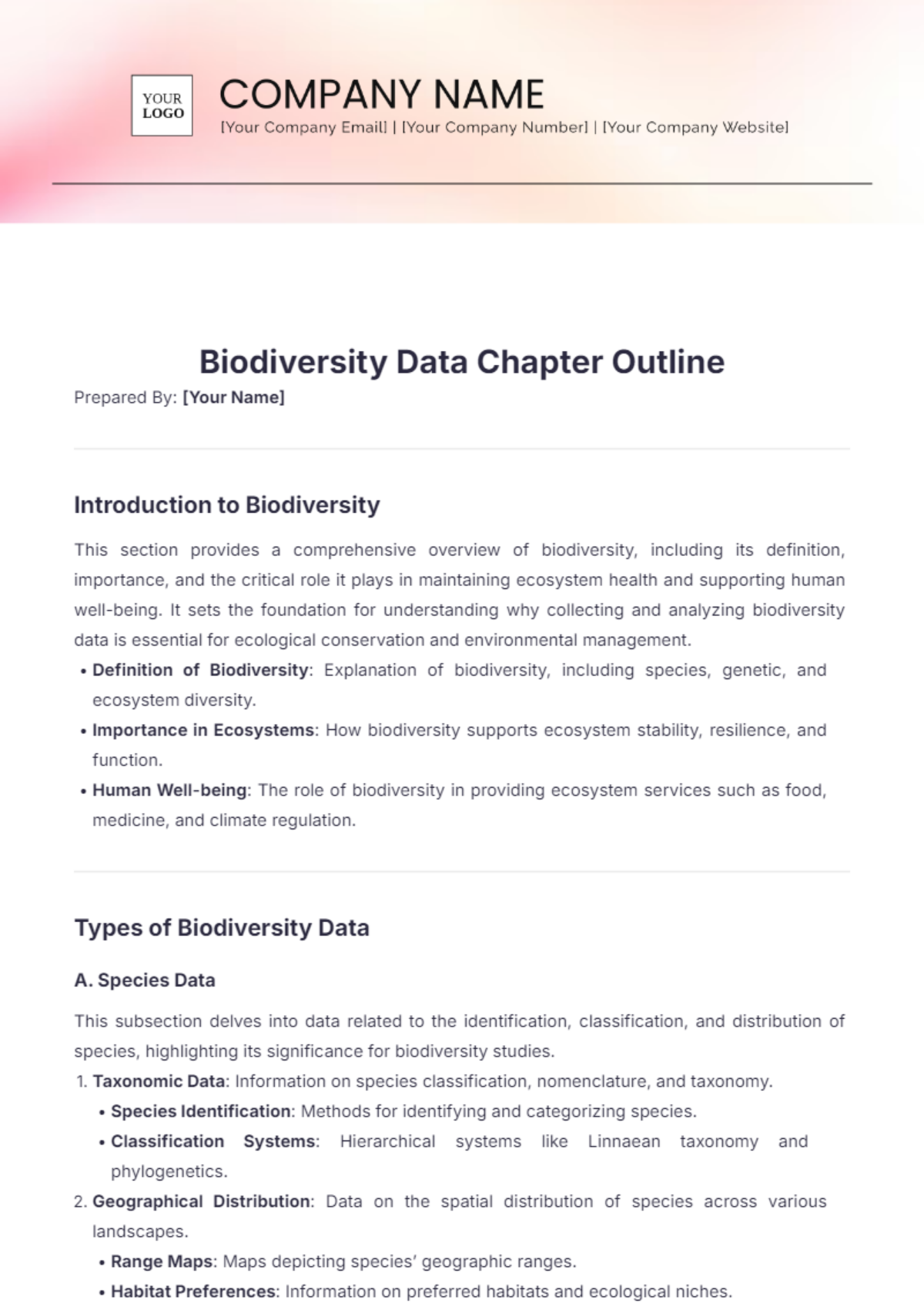Biodiversity Data Chapter Outline
Prepared By: [Your Name]
Introduction to Biodiversity
This section provides a comprehensive overview of biodiversity, including its definition, importance, and the critical role it plays in maintaining ecosystem health and supporting human well-being. It sets the foundation for understanding why collecting and analyzing biodiversity data is essential for ecological conservation and environmental management.
Definition of Biodiversity: Explanation of biodiversity, including species, genetic, and ecosystem diversity.
Importance in Ecosystems: How biodiversity supports ecosystem stability, resilience, and function.
Human Well-being: The role of biodiversity in providing ecosystem services such as food, medicine, and climate regulation.
Types of Biodiversity Data
A. Species Data
This subsection delves into data related to the identification, classification, and distribution of species, highlighting its significance for biodiversity studies.
Taxonomic Data: Information on species classification, nomenclature, and taxonomy.
Species Identification: Methods for identifying and categorizing species.
Classification Systems: Hierarchical systems like Linnaean taxonomy and phylogenetics.
Geographical Distribution: Data on the spatial distribution of species across various landscapes.
Range Maps: Maps depicting species’ geographic ranges.
Habitat Preferences: Information on preferred habitats and ecological niches.
Population Dynamics: Data on species population sizes, trends, and dynamics.
Population Estimates: Techniques for estimating population sizes.
Population Trends: Monitoring changes in population over time.
B. Genetic Data
This subsection covers data related to genetic variation within and between populations, crucial for understanding genetic diversity and evolutionary processes.
Genetic Variability: Measures of genetic diversity within populations.
Allelic Diversity: Variability of alleles within a population.
Genetic Drift: Changes in allele frequencies due to random sampling effects.
Molecular Markers: Tools used to study genetic variation.
Microsatellites: Short, repetitive DNA sequences used as genetic markers.
SNPs (Single Nucleotide Polymorphisms): Variations at a single nucleotide position.
Genomic Data: Comprehensive genetic information obtained through sequencing technologies.
Genome Sequencing: Techniques for sequencing entire genomes.
Comparative Genomics: Comparing genomes across species to study evolutionary relationships.
C. Ecosystem Data
This subsection provides insights into data related to ecosystems, including their structure, functions, and interactions among biotic and abiotic components.
Habitat Types: Classification and description of different habitat types.
Terrestrial Ecosystems: Forests, grasslands, deserts, etc.
Aquatic Ecosystems: Freshwater, marine, and estuarine systems.
Community Composition: Data on species interactions and community structure.
Species Assemblages: Groupings of species in a particular area.
Trophic Interactions: Food webs and energy flow within ecosystems.
Ecosystem Services: Benefits ecosystems provide to humans.
Provisioning Services: Resources like food and water.
Regulating Services: Climate regulation and pollination.
Methods of Biodiversity Data Collection
1. Field Surveys
This subsection discusses traditional methods of collecting biodiversity data through direct observation and sampling in the field.
Transects
Quadrats
Camera traps
2. Remote Sensing
This subsection covers the use of satellite imagery and aerial surveys to collect data on biodiversity over large areas.
Satellite imagery
Drone surveys
LiDAR
3. Genetic Methods
This subsection discusses modern techniques like DNA barcoding and metagenomics used for biodiversity assessment.
DNA barcoding
Environmental DNA (eDNA)
Metagenomics
Biodiversity Data Management
1. Data Storage
This subsection covers various ways to store biodiversity data, including databases and repositories.
Relational databases
Cloud storage
Data repositories
2. Data Standards
This subsection discusses the importance of standardizing biodiversity data for interoperability and data sharing.
Metadata standards
Data formats
Taxonomic standards
3. Data Sharing and Accessibility
This subsection covers how to make biodiversity data accessible to researchers, policymakers, and the public.
Open data initiatives
Data portals
Licensing and permissions
Applications of Biodiversity Data
1. Conservation Planning
This subsection covers how biodiversity data is used in planning and implementing conservation efforts.
Protected area designation
Species recovery programs
Habitat restoration
2. Ecological Research
This subsection discusses the role of biodiversity data in advancing our understanding of ecological processes.
Species interactions
Community dynamics
Ecosystem functioning
3. Environmental Monitoring
This subsection covers how biodiversity data is used in monitoring environmental changes and assessing ecosystem health.
Bioindicators
Long-term ecological monitoring
Impact assessments
Challenges in Biodiversity Data
1. Data Gaps
This subsection discusses the issues related to incomplete or uneven data coverage.
Taxonomic gaps
Geographical gaps
Temporal gaps
2. Data Quality
This subsection covers the challenges in ensuring the accuracy and reliability of biodiversity data.
Data verification
Sampling bias
Measurement errors
3. Data Integration
This subsection discusses the difficulties in combining data from different sources and formats.
Interoperability issues
Harmonization of datasets
Metadata inconsistencies
Future Directions in Biodiversity Data
1. Technological Innovations
This subsection explores emerging technologies that could revolutionize biodiversity data collection and analysis.
Artificial Intelligence
Machine Learning
Blockchain for data integrity
2. Policy and Collaboration
This subsection discusses the importance of policies and international collaboration in advancing biodiversity data efforts.
Global biodiversity agreements
Collaborative research networks
Funding and resources

















































